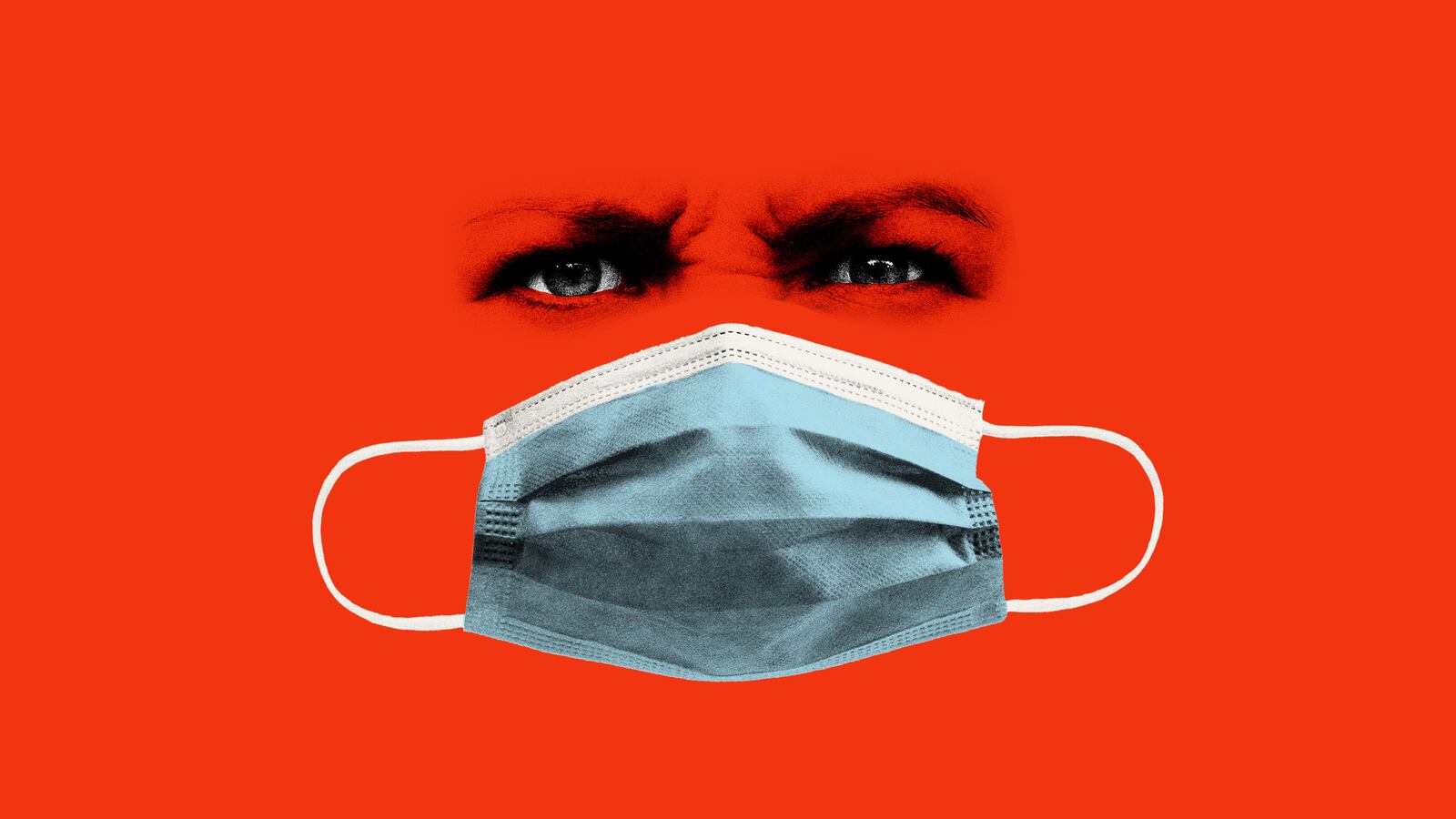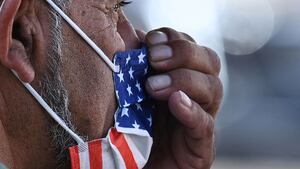In March 2020, as lockdowns gripped the world and the COVID-19 pandemic was officially in full swing, Lisa Brosseau, a national expert on respiratory protection and infectious diseases at the Center for Infectious Disease Research and Policy, was pleading with the CDC to “follow the science.” Contrary to the information from the CDC and WHO at the time, Brosseau—and other experts who would soon follow—thought the SARS-CoV-2 virus that causes COVID-19 could be transmitted via aerosols: tiny particles emitted when an infected person talks, sings, or breathes. Aerosols are, by definition, smaller than the “droplets” emitted by sneezing and coughing, and can travel further in the air than bigger droplets can. Viral transmission can occur when a non-infected person inhales these small aerosolized particles, and research would soon show aerosols are a primary means of SARS-CoV-2 transmission.
But in March 2020, when Brosseau started making a case for aerosolized transmission, the CDC and the WHO insisted that the virus was primarily transmitted through droplets and fomites (touching something an infected person touched).
This debate wasn’t simply academic or semantic; it had—and has—very real consequences for how people protect themselves and others from contracting the virus. Good ventilation is critical, as Brosseau told The Daily Beast at the time, and a fit-tested respirator like an N95 is significantly more effective at filtering small particles than a cloth face covering or surgical mask. It took the WHO a year and a half and the CDC two years to fully acknowledge the reality of aerosol transmission of SARS-CoV-2, including that well-fitting respirators approved by the National Institute of Occupational Safety and Health (NIOSH) “offer the highest level of protection.”
But aerosol and occupational health experts are again sounding the alarm. The Health Infection Control Practices Advisory Committee (HICPAC) advises the CDC and Department of Health on guidelines for infection control in health-care settings—standards that were last updated in 2007. According to Brosseau, these guidelines are typically adopted by the CDC and thus considered “guidance from on high” by hospital systems.
HICPAC will meet in August and may vote on proposed updated guidelines for infection control—and it may end up exacerbating concerns rather than assuaging them. An informational slide deck outlining the committee’s proposed updated guidelines, obtained and reviewed by The Daily Beast, makes little mention of aerosol transmission of viruses, and cites what experts say are flawed studies to suggest there is no difference in the protection offered between respirators like N95s and surgical masks.
If accepted, the guidelines could enshrine unsafe practices for health-care workers at a time when the industry is already suffering from critical staffing shortages.
In the section discussing pathogen transmission, there is only a cursory mention of aerosols and airborne transmission, but no real discussion of the types of protection needed for different types of viruses. More shocking, however, is the Evidence Review at the end of the slide deck, in which the studies cited by HICPAC as supporting evidence of its conclusions do not appear to be as robust and persuasive as many public health experts expected.
Dr. Robert Harrison, an occupational medicine specialist and a clinical professor at the University of California, San Francisco, told The Daily Beast the evidence cited in the slide deck guidelines flies in the face of “clear science.”
Citing 13 different studies of laboratory-confirmed viral respiratory infections, a summary chart at the end of the presentation concludes there is “no difference between surgical masks and N95s in preventing respiratory infections.”
This determination contradicts what aerosol scientists, occupational health specialists, and the CDC itself—including HICPAC’s 2007 guidelines—have told the public.
“If a virus is aerosol transmissible, there’s no question that it’s better to wear a fit-tested N95 [than a surgical mask]. There’s just no question. I would be surprised if anyone would argue with that statement,” said Harrison.
Dr. Sharon Wright, one of the co-chairs for HICPAC, declined to answer questions about the new guidelines proposal; and instead referred The Daily Beast to CDC press officer Martha Sharan, who provided The Daily Beast with a statement that reads in part: “This Guideline incorporates the most recent evidence that describes how germs are spread in healthcare settings and provide general and germ-specific recommendations to prevent transmission. This includes recommendations on the use of PPE, such as N95 respirators.” The CDC did not comment on the conclusions HICPAC has made about the efficacy of surgical masks compared to N95 respirators.
Of the 13 studies cited as supporting evidence for the new guidelines proposal, HICPAC conceded 10 are retrospective and at risk of recall bias—systemic errors resulting from participants’ inaccurate or incomplete recollections—and that two of the studies have only small sample sizes.
HICPAC also wrote in its proposed new guidelines that in 10 of the 13 studies cited for supporting evidence, the authors “either did not report on [mask or respirator] compliance or did not report compliance measured objectively.” In some cases, the protocol for fit testing an N95—the process by which clinicians ensure there are no gaps around the mouth or nose of the respirator—wasn’t defined.
There are other flaws with the methodologies in the studies; in some cases, Brosseau said, health-care workers were only told to wear masks or respirators when they thought they might be exposed to a pathogen.
“We know that if people only wear them when they think they might be exposed, there’s a high likelihood they’ll be exposed at another time,” she said.
One 2022 study cited in the Evidence Review investigated the safety of health-care workers who wore surgical masks versus those who wore respirators. It received immense pushback last year from health-care workers, who raised ethical concerns about having participants during a pandemic wear surgical masks despite them being less effective than respirators. The Public Health Agency of Canada eventually determined that health-care workers could choose which to wear. But according to Brosseau, the study authors faced tough challenges finding health-care workers who could participate and wear surgical masks instead of respirators, and had to look abroad to places like Egypt, Israel, and Pakistan—“countries with really different medical health-care systems,” she said.
“These are just really badly designed and executed studies,” she added.
In a remarkable footnote about the 13 studies, HICPAC noted that, despite the issues with recall bias and other factors that could have confounded the studies’ results, “it is not expected that the addition of new evidence will alter these findings.”
The CDC’s own published data supports the use of N95 respirators over surgical masks. Real-world data taken between February and December of 2021 found that in indoor public settings, continuous use of N95 and KN95 respirators cut the odds of infection by 83 percent compared to 66 percent with surgical masks.
The FDA is also very clear on the subject, saying on its website that surgical masks may help with source control (preventing an infected person from spreading SARS-CoV-2), but they don’t provide personal protection against inhalation of SARS-CoV-2.
For Brosseau, it’s simply mind-boggling to suggest that surgical masks provide comparable protection to a fit-tested respirator against hazardous aerosols.
“We don’t use surgical masks in any other context,” she said. “In any other industry, I’d be run out on a rail if I suggested a surgical mask for exposure to a hazardous aerosol. So why [does HICPAC] think this is a good idea?”
Two Steps Forward, Three Steps Back
Peg Seminario was the director of occupational safety and health for the AFL-CIO from 1990 until her retirement in 2019. She called the guidelines outlined in the slide deck “Really astonishing. And frightening.”
“People are still getting sick and dying from SARS-CoV-2; they’re still getting long COVID,” Seminario said, adding that health-care workers are still significantly more at risk of contracting the virus than the average person.
Despite that, said Seminario, HICPAC’s proposed guidelines are “all based upon trying to minimize protections, rather than being responsive to the science and providing a strong level of protection. We’re talking about health-care workers exposed to suspected and confirmed patients.”
Seminario was particularly appalled to see the slide deck mentioned almost nothing about ventilation. In the “transmission-based precautions” section, the slide deck simply stated that health-care workers should “take advantage of multiple layers of interventions (e.g., PPE, rooming, ventilation, disinfection) to reduce the risk of transmission.” Yet there is nothing about ventilation in the evidence review.
Brosseau said the lack of discussion about ventilation is one of the things “that makes me think that they’re trying to turn everything into a droplet disease and not recognize small aerosol particles, or the distribution of those particles throughout a space. All of that is going to just disappear.”
Brosseau and Seminario said the lack of focus on worker safety indicates a larger problem in health care of putting profit over safety.
According to Seminario, “[Hospital administrations] don’t want to spend the money. Fit testing is a big issue you have to do for respirators. That takes time and money. So if they can say, ‘Oh, a surgical mask is just as good,’ they can get around those expenses.” Upgrading ventilation systems is exponentially more costly as well.
Amber Mitchell, an infectious disease and occupational health specialist and president of the nonprofit International Safety Center, pointed out that another obstacle to contend with is that the new guidelines may run counter to what’s mandated by the Occupational Safety and Health Administration (OSHA) that oversees workplace safety standards in the U.S. OSHA “doesn’t have ‘guidelines’—they have enforceable standards,” said Mitchell. For infection prevention and control, OSHA has the Bloodborne Pathogens Standard and the Respiratory Protection Standard, which includes fit testing for respirators like N95s.
OSHA has “always been at odds with CDC and HICPAC over the years on occupational infection prevention,” said Mitchell. According to Seminario, HICPAC and the CDC “don’t like OSHA making requirements for health care and having oversight over health-care workers.”
So despite OSHA’s purported oversight, new CDC guidelines may give hospital systems some cover to take the quicker and cheaper option—with significant implications for hospital workers.
“When hospitals are seeking accreditation, the joint commission is looking for them to have followed guidelines, including those from the CDC,” Brosseau said. “If they haven't made decisions in the context of these guidelines, they will be in trouble.”
With such profound implications for health care and health-care workers, all four public health experts who spoke to The Daily Beast said HICPAC’s refusal to include a broad range of stakeholders, including the public, in the discussion around respiratory and mask guidelines is deeply irresponsible.
“The lack of transparency is startling,” Seminario said. “The minutes for past meetings are only bare bones. They have no transcripts. No presenters. There's nothing. It’s just outrageous. It’s a federal advisory committee.”
The solution, Brosseau added, is simple: HICPAC needs to open the process up by publishing its recommendations publicly and allowing for a comment period. Instead of having three minutes of public questions at the end, here should be “something like a docket, where they have to be responsive to the comments they receive,” she said.
Harrison also emphasized the need to bring in feedback from frontline healthcare workers and their representatives. “I have always found that getting feedback from the impacted worker communities is critical to formulating the best recommendations and policies,” he said.
The CDC statement to The Daily Beast stated that HICPAC members want to hear from the public and that there is dedicated time to do so at the end of HICPAC meetings.
That’s not enough, say the experts who spoke to The Daily Beast.
There is still time to open this process up, Harrison said. “Right now, we’re trying to put up a yellow caution light, like, ‘Let’s slow down and ensure everybody is on the bus.’” Failing to do so could drastically affect health-care workers, and may further erode the public’s trust in public health organizations—which already took a big hit after the slow and inconsistent acknowledgment of aerosol transmission of SARS-CoV-2.
For Brosseau, the risk of pushing forward bad guidelines without stakeholders’ input could decimate what remaining trust in the CDC exists, and make even staunch supporters believe it is “going backward. They’re going to be shocked.”
“The decisions some of these public health people are making are not getting better,” she said. “They’re getting worse.”











